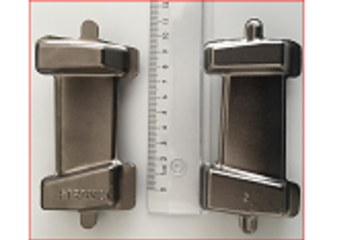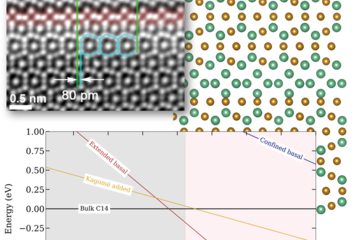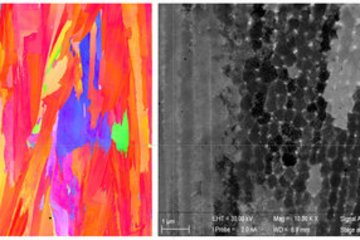All genres
221.
Poster
Investigation of the polymer/oxide/metal interface stability with an in-situ Scanning Kelvin Probe Blister Test. ISE Spring Meeting 2010, Columbus, OH, USA (2010)
222.
Poster
In-situ XAS investigations of the ZnO(0001)–Zn surface and electrolyte interface during dissolution and as a function of pH. Gordon Research Conference, Science of Adhesion, Colby-Sawyer College, New London, NH, USA (2009)
223.
Poster
Electrochemical Studies in Adhesion Science. Meeting of the Society of German Chemists (GDCH), Section Electrochemistry, Gießen, Germany (2008)
224.
Poster
Structural Characterization of Ag Nanoparticles Embedded in TiO2 Thin Films Prepared by Means of RF-Magnetron Sputtering. AVS fall meeting 2008, Boston, MA, USA (2008)
225.
Poster
Nanoscopic understanding of the surface chemistry and stability of polar ZnO(0001)-Zn surfaces in aqueous solutions. The 59th Annual Meeting of the International Society of Electrochemistry, Seville, Spain (2008)
226.
Poster
Surface enhanced Raman spectroscopy and Scanning Kelvin Probe studies of corrosive de-adhesion at polymer-metal interfaces. The 59th Annual Meeting of the International Society of Electrochemistry, Seville, Spain (2008)
227.
Poster
Silver Nanoparticles Embedded in Layer by Layer Polyelectrolyte Thin Films: Investigation of the Formation and Composition of Silver Nanoparticles. Polyelectrolytes 2008, Coimbra, Portugal (2008)
228.
Poster
Adsorption of Organosilanes on ZnO Surfaces. 2nd IMPRS-SurMat Workshop in Surface and Interface Engineering in Advanced Materials, Ruhr-Universität Bochum, Bochum, Germany (2008)
229.
Poster
Hydrated Ion Transport at Polymer/Oxide/Metal-Interfaces in Non-Corrosive Atmosphere: Influence of Electric Field Gradients. Gordon Conference Graduate Research Seminar on Aqueous Corrosion, Colby Sawyer College, New London, NH, USA (2008)
230.
Poster
Acidic dissolution mechanism, pH-dependent stability and adhesion of single molecules studied on single crystalline ZnO(0001)–Zn model surfaces by in-situ AFM studies. Gordon Conference Graduate Research Seminar on Aqueous Corrosion, Colby Sawyer College, New London, NH, USA (2008)
231.
Poster
Influence of iron oxide films on the adhesion and delamination of organic coatings. Gordon Research Conference on Aqueous Corrosion 2008, New London, NH, USA (2008)
232.
Poster
Acidic dissolution mechanism, pH-dependent stabilization and adhesion of single molecules on single crystalline ZnO(0001)–Zn model surfaces studied by in-situ AFM and DFT simulation. PSI-k Summerschool for Modern Concepts for Creating and Analyzing Surfaces and Nanoscale Materials, Sant Feliu de Guixols, Spain (2008)
233.
Poster
Study of Molecular Adhesion on ZnO(0001) by means of Single Molecule Adhesion Studies. 15th WIEN2k workshop, Vienna, Austria (2008)
234.
Poster
UV coil coating - Importance of thermal treatment. Radtech Europe, Wien, Austria (2007)
235.
Poster
Adsorption of organosilane molecules on polar ZnO(0001) surfaces. 12th European Conference on Applications of Surface and Interface Analysis (ECASIA'07), Brussels, Belgium (2007)
236.
Poster
Adsorption kinetics of organophosphonic acids on plasma modified aluminium surfaces. 12th European Conference on Applications of Surface and Interface Analysis (ECASIA'07), Brussels, Belgium (2007)
237.
Poster
Monte Carlo Simulation of Temperature Programmed Desorption Including Binding Energies and Frequency Factors Derived by DFT Calculations. 43rd Symposium on Theoretical Chemistry, Saarbrücken, Germany (2007)
238.
Poster
Correlation of Structure and Corrosion Resistance of Ultra-Thin SiO2 Plasma Polymer Films at Polymer/Metal Interfaces. 12th European Conference on Applications of Surface and Interface Analysis (ECASIA07), Brussels, Belgium (2007)
239.
Poster
Nanomechanics of thin glassy polystyrene films. 1st IMPRS-SurMat Workshop on Surface and Interface Engineering in Advanced Materials, Klosterhost, Germany (2007)
240.
Poster
Barrier and Release Properties of Thin Model Ag/fluorocarbon Plasma Polymer Nanocomposite Films. EuroNanoForum 2007, Nanotechnology in Industrial Applications, Düsseldorf, Germany (2007)








